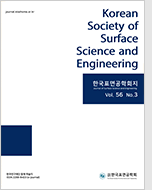
- Past Issues
- e-Submission
-

2021 Impact Factor 1.766
5-Year Impact Factor 1.674
Editorial Office
- +82-2-563-0935
- +82-2-558-2230
- submission@kssse.or.kr
- https://www.kssse.or.kr/

2021 Impact Factor 1.766
5-Year Impact Factor 1.674
The Korean Society of Surface Science and Engineering 2024;57(3):179-191. Published online: Jul, 8, 2024
DOI : 10.5695/JSSE.2024.57.3.179
This study focuses on improving the photocatalytic degradation efficiency by synthesizing a TiO2/WO3 composite. Given the environmental significance of photocatalysis and the limitations posed by TiO2's large bandgap and high electron recombination rate, we explored doping, surface modification, and synthesis strategies. The composite was created using a ball mill process and heat treatment, analyzed with field emission scanning electron microscope, high resolution X-ray diffraction, Raman microscope, and UV-Vis/NIR spectrometer to examine its morphology, composition and absorbance. We found that incorporating WO3 into the TiO2 lattice forms a Wx-Ti1-x-O2 solution, with optimal WO3 content reducing the band gap and enhancing sterilization efficiency by inhibiting the anatasese to rutile transition. This contributes to the field by offering a way to overcome TiO2's limitations and improve photocatalytic performance.
Keywords TiO2; WO3; Photocatalysis; Ball mill; Heat treatment